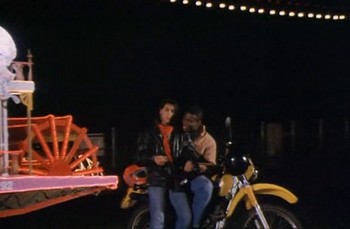
Hasidia (Sarita Khajuria and Oliver (Mo Sesay) seen from the bus (Bhaji on the Beach, 1993): modern reality transforms the romantic image

Wm Darcy (Martin Henderson) and Lalita (Aiswarya Rai) walking on LA beach (Bride and Prejudice 2005): romance scene left fantasy but with addition of cultural disparities
Dear friends and readers,
For the last couple of weeks now I’ve been watching the 6 Sense and Sensibility films still available, and a group of Indian films, mostly Tamil, powerfully great ones, Roja, Bombay, Guru by Mani Ratnam; plus the two other recent Indian adaptations of Austen, Bride and Prejudice and Aisha. I’ve watched two transnationals: Bhaji on the Beach and Mississippi Masala. And I’ve read in whole and parts several superb books on Indian cinema and essays on individual films.
I had watched them before (see earlier blog on Lagaan, Guru, Bombay, Charuntula, Mississippi Masala) but this time it was with a view to understanding and then writing a paper on Rajiv Menon’s I Have Found It, the 2000 Tamil analogous or free adaptation of S&S.
I’ve come to a few general conclusions. Jane Austen’s novels — or novels of the 18th & 19th century — seem peculiarly suitable for contemporary Indian films, from the typology: chaste heroine, intelligent assertive yet tactful and acquiescent in her subordinate position to men; she also regards having and bringing up children one of her main functions in life. Austen and the English traditions of middle class novels also contain social criticism from the angle of the vulnerable or underdog combined with women’s romance. Finally, they have ethical heroes who are ambitious and want to marry and are respectful of women, the traditional family group, and the arranged marriage for money (for themselves as well).
Further, if we look at the four faithful movies, we find her material has forced upon the film-makers images of displacement, journeys, exile from home:
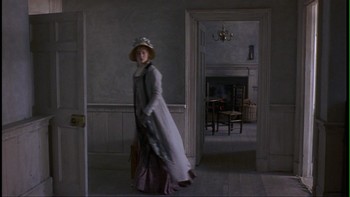
Striking & memorable image of Marianne pacing un-home-y space (not usually discussed, in “faithful” 1995 S&S)
Turning to both free adaptations, I Have Found It is filled with sudden journeys, by train, by bus, by truck; the characters stand outside buildings they are excluded from; the Elinor character Sowmya has a hard time getting a job and the family is harassed for rent and lacks food for a time; they live in a rented apartment, in danger of eviction. They had lived in a palace type house in their village before the grandfather died and cut his daughter, the equivalent of Mrs Austen, off without any money.
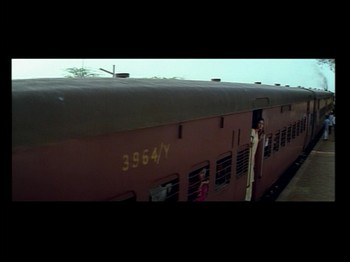
The family’s train journey away from village (I Have Found It)
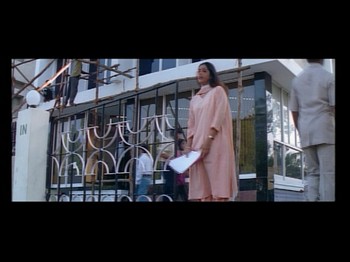
Sowmya-Elinor can find no place, outsider in Chennai
From Prada to Nada makes the trip from West to East LA profoundly transformative of everything the sisters have known:
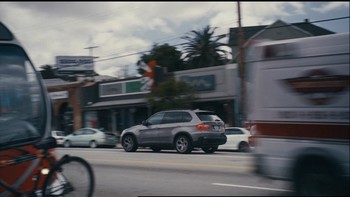
Crossing from west (white, rich) to east (Spanish, poor) LA (From Prada to Nada, 2010)
Since I’m interested in Indian films here I turn also to Aisha too. Despite the static quality of Emma’s life in the novel becomes a film of journeys. Aisha is conceived of as a romance about an upper class girl with plenty of leisure time to spend her life socializing in her milieu, but what does she do but tak journeys between four places cities, a town not far from Delhi; Delhi; a resort area; Bombay:
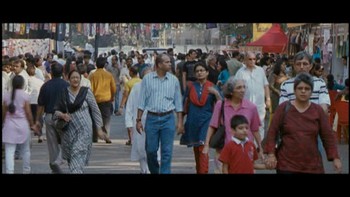
Mumbai seen from the angle of Aisha’s car
Aisha’s coming-of-age story and confused inner life is mirrored in these concrete displacements:
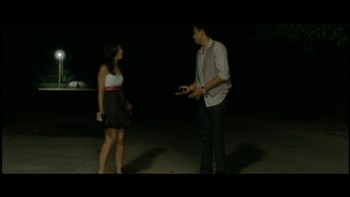
Aisha has many car scenes; here the characters (Shefali and Gambhir) have been tricked by Aisha & are w/o their car and are in a dangerous unknown area, must find & walk home (Aisha)
When I compared Gurinda Chadha’s transnational Bhaji on the Beach together with Bride and Prejudice & distinguished the features of Austen’s 1813 Pride and Prejudice from all that accrues in one’s mind: I saw that Chadha took on board, added, as part of what estranges our lovers in B&P a displaced young man (Wm Darcy) and a journeying set of sisters at risk. Bride and Prejudice is filled with images of journeying, of people displaced, suddenly turning up; planes, bridges, odd angled cities juxtaposed are noticed by many. But the images of moving, of loss, of zoom shots are continual and many unnoticed. The many cars laden with family belongings:
When Jaya-Jane and Balraj-Bingley are separated a visual image of a train on a desolate landscape appears:
This is part of what makes the imitation of Austen’s P&P plot-outline touching beyond the beauty and energy of the dances & songs. Austen’s P&P had nothing to do with cultural liminality and yet the novel lends itself to this sort of deepening treatment.
Since it’s not well enough known by Janeites or Austen scholars, and at the present time the only way to get it is to pay to have a DVD manufactured on demand, I’ll describe Bhaji on the Beach.
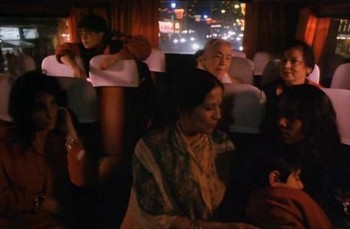
One of the many scenes of the women in the van (this one at evening, coming home)
From “Representing the Spaces of Diaspora in Contemporary British Films by Women Directors,” by Anne Ciecko, Cinema Journal, 383 (Spring, 1999), pp. 67-90:
Bhaji on the Beach takes place in the course of a single day. The film begins with a journey down a street in Birmingham, offering glimpses of England’s second-largest city as a marketplace of diversity … Birmingham is [the] place of departure, and the ultimate destination is Blackpool for a summer holiday. In a series of short, parallel-edited vignettes, the viewer is introduced to the dramatis personae, a wide range of pilgrims of different ages (mostly middle class)-women of South Asian ethnic backgrounds- all headed on a day trip to Blackpool sponsored by the Saheli Women’s Center. Through the character of the group leader, Simi, Chadha and her screenwriter, Meera Syal, foreground the site of the Asian women’s refuge and resource center, which provides facilities, advice, services, and information to the community, concentrating on women’s issues with a strong focus on the family.
We have three separate stories threading their way through the trip and day long outing. The first is Asha (Lalita Ahmed), a middle aged Indian women terrorized by her nightmare Gods, who appeases them by saying she will know her place; she slowly emerges from her nightmare and finds herself stumbling among huge grocery store goods, which come down to normal size and she is in a grocery and her family just behind waiting for her to make them lunch. Over the course of her day at Blackpool, she will meet, walk, and talk with a lonely gallant ex-actor British (white) man.
We switch to Ginder (Kim Vithana), a Southasian young woman in her mid-20s reading a letter on a stairway; these turn out to be divorce papers; she goes into the room where her son is and he asks when they will see Daddy in this new place they are moving to. She says she can’t answer that but today they are going to seashore, and she feigns or feels some relief to get out of their tight quarters. We switch to an empty cot for child, near by Ranjit (Jimmi Harkishin) angry Southasian young man on another bed with similar letter; and his young brother, Manjit (Akbar Kurtha) comes in and he cries with real rage, “Will no one ever leave him alone in this family.” Manjit wants to be reasonable (and prevents his brother from kidnapping his son later in the movie) and with a bully tyrannical older brother, Ranjit chases Ginder down to Blackpool, to try to persuade her to return to him and his family on his terms. We learn from seeing her body he has beaten her, and he tries to again as a way of subduing her. He is unable to change his destructive life patterns.
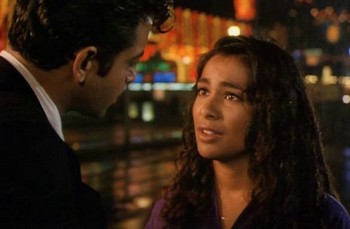
Ginger makes one last appeal to Ranjit
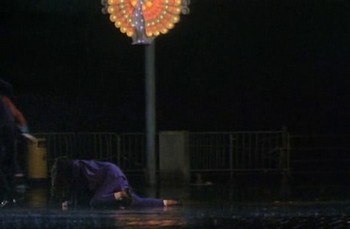
This opening with an insistence he listen to her and make a separate home for them results in his hitting and throwing her on the ground
The third couple is comprised of a 21 year old Southasian girl, Hasidia, daughter of aspiring parents; she has made medical school and they want her to be a physician. She finds she is pregnant by Oliver, her black English boyfriend (Afro-Carribean?) whose existence the parents do not know about — only partly because he’s black. Over the course of the day she argues with him, phones him, he tries to find her; she finds out about abortions and they meet again at the beach where he too followed her. The most directly hopeful moment of the film occurs when they agree they must do the abortion, they are not in a position to marry or bring up a child, but they will see it through together, and they are last seen in the shot I put at the head of this blog, on his bike.
On the bus are relatives of both young women, a grandmother, an aunt, Pushka (Zohra Sehga), Rekhan (Souad Faress) a Indian woman who lives in Bengal. There are two younger women who are “taken out” (or harassed, depending on your point of view) by some British young men (louts is the feel). They wear combinations of traditional and modern British dress.
The film also makes humorous references to the artificial conventions of popular Indian movies, as in the stylized fantasy sequence in which Asha dances in the rain until she is jolted out of her reverie when the man who courts her is revealed to be [her eldely English escort] Ambrose (his brown makeup washes off) … The whole place has a liberal and liberating atmosphere about it; at the same time, it is stiflingly cluttered and consumerist. The Blackpool “illuminations,” the late-summer lighting up of the tacky town with Christmas lights, is ostensibly the reason the women’s group has chosen this place for the summer getaway. … The women from Birmingham are allowed to enjoy the spectacle at the end of the film, when the darkening streets are lit up and the place takes on a unique beauty. Despite the heavy situations encountered along the way, the film has a comforting tone. They also bring with them the enormous symbolic baggage of tradition. Befitting the carnivalesque environment of Blackpool, many are in costume or change their clothing along the way, as if taking on the guise or garb of the “other.”
I felt as with Mira Nair’s Namesake (see Natalie Friedman’s “From Hybrids to Tourists: Children of Immigrants in Jhumpa Lahiri’s The Namesake, Critique: Studies in Contemporary Fiction, 50:1 (2008): 111-27)and Mississippi Marsala which combines an ethnically diverse Southern American town culture with India culture (from Uganda), in Bhaji on the Beach, I could discern the archetypes of Indian filmic culture in this hybrid form.
Mira Nair’s Mississippi Masala like her adaptations in general are in mood quite different from Chadha’s — far more grave, melancholic, with more emotional depths. Chadha uses stereotypes far more: of course the husband is wretched and violent; of course the wife longs to return but “I can’t.” Individuals are far more various than this; some hybrid people are happy, not punished, have parents who sympathize. As B&P is shallow easy romance, so Bhaji on the Beach is a situation comedy in type. Nair gets beneath the stereotypes to suggest another self which does not have any public space to be. Nair’s Mississippi Massala uses strong melodramatic patterning (the opening flashback of Indian films, the wedding, the dance) while Bhaji on the Beach is more Western in tropes and does have the inconsequentality of life in feel because of many events not part of the plot-design. Yet in both the same imagery and concern with homelessness, exile, displacement prevails (so too Nair’s Namesake).
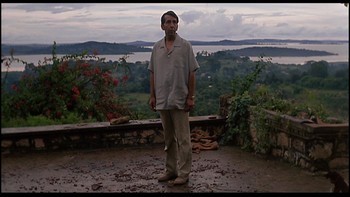 Jay (Sethman Roth), the exiled Asian Uganda eagerly returning (from Mississippi) by plane, car to discover he has been dreaming of ghosts, of what is not (Mississippi Masala)
Jay (Sethman Roth), the exiled Asian Uganda eagerly returning (from Mississippi) by plane, car to discover he has been dreaming of ghosts, of what is not (Mississippi Masala)
This blog is meant to be suggestive only. I’m working out some thoughts. So I turn to Bishnupriya Ghosh and Bhaskar Sarkar’s “The Cinema of Displacement: Towards a Politically Motivated Poetics,” Film Criticism, where they write:
Home is largely construed in terms of the land to which one belongs: land is a cultural repository of memories and symbolic of a way of life … The spaces that the protagonists occupy become a central feature in their acts of self- representation. In films representing displacement, the protagonists seem to locate themselves in a curious double space. The space in tiie mise-en-scene – a room, a train station, a porch – always evokes an “other” space.
I add the dominant principle in the relationship between the double spaces is intrusion. There is a constant traversing of space.
All six S&S films show the above emotional characteristics & imagery: psycho-social distress becomes literal displacement and liminality. I move from first seeing the Dashwood women lamenting on the stairwell in the 71 S&S:

We see the 3 Dashwood women pressed together on the stairwell surrounded by new furniture crowding them out (1971 S&S);
to the many grim journeys of the 81 S&S; to the dwelling on melancholy stark and fearful landscape in the 95 S&S (even gardens are nightmarish and a piano has to be hauled up a hill); to continual displacements of I Have Found It (2000), and the continual movement of Davies’s 2009 S&S

The classic coach journey (2008 S&S)
culminating most recently (2011) in the use of zoning and moving trucks in From Prada to Nada, where Edward and Nora-Elinor’s love scenes are conducted next to a moving van.
Virginia Woolf pointed out in 3 Guineas how most women have no state for real — if they want any liberation; Carole Pateman that they are attached to the society they live in through men or families who however can eject them at will. These insights are pictured in these films out of Austen.
Ellen

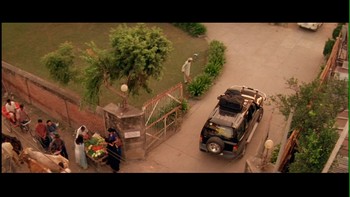
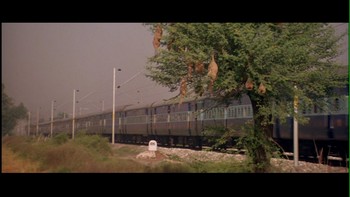
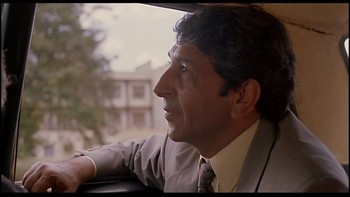
P.S. List of books:
S. Theodore Baskaran. History through the Lens: Perspectives on Suoth Indian Cinema. Super on its topic.
Sumita S. Chakravarty. National Identity in Popular Cinema, 1947-87. This is particularly useful. Chakravarty’s comments and explanations hold for other cinemas too, such as from motifs like the use of a woman looking at a mirror, to large patterns: history films show 3 types of history: what’s happening in the film; what’s happening in the audience’s world at the time of screening; what’s presented or understood as history (for the particular culture) in a long view sense.
K. Mot Gokulsing and Wimal Dissamayak.e Indian Popular Cinema: a narrative of cultural change. Beautifully readable and sums up good points you read elsewhere; lots of understandable descriptions of specific movies.
Dina Lordanaova, et alia, ed. Cinema at the Periphery
Vijay Mishra. Bollywood Cinema: Temples of Desire. Insightful in deep sense.
Hamid Naficy. An Accented Cinema: Exilic and Diasporic Filmmaking Taxonomis of kinds of exiles, diasporic people.
Selvaraj Velayautham, ed. Tamil Cinema: cultural politics of India’s other film industry. Super on its thematic topics (women in the films).
See also
Morley, David and Kevin Robins, “Spaces of Identity: Communications Technologies and the Reconfiguration of Europe,” Screen 30:4 (1989):10-34
I should say these themes resonate with me, only from a different turn. When I read Jhumpa Lahiri’s Namesake, I remembered how I have felt a desperate need to throw off the identity imposed on me by parents and my ethnic culture, how I longed to go to the UK as there I had constructed a dream identity out of books, and like the characters in Andrea Levy’s Small Island, how quickly I saw how deluded I’d been and also found that my ethnic identity as an American or NYC white woman, lower middle class, has been inescapable.
Many of us are ex-pats now and one might like to think an acknowledgement of the creolization of the world’s space over the past couple of centuries provides a hope for toleration and peace and sharing — only I think it will take more than that now.
Ellen